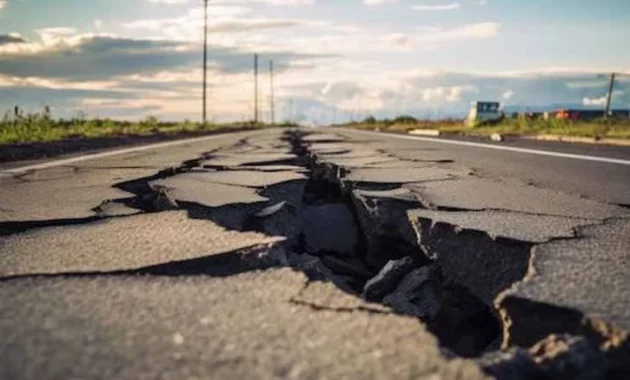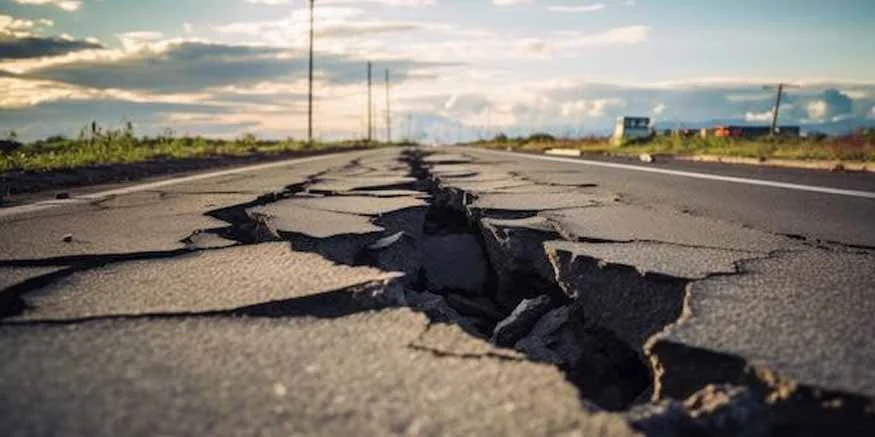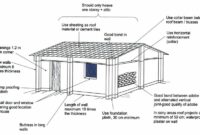Earthquake Resistant House – Building homes that are earthquake-resistant is not just a trend—it’s a necessity in regions prone to seismic activity.
Every year, earthquakes cause significant damage to structures, leading to loss of property and lives.
However, with the right planning and construction techniques, homes can be designed to withstand earthquakes, providing safety and peace of mind to homeowners.
In this article, we will discuss the key ideas behind earthquake-resistant house design and the essential details at every step of the process.
1. Site Selection: Choosing the Right Location
The first step in building an earthquake-resistant house begins with selecting a suitable site. Avoiding hazardous areas is crucial:
- Avoid fault lines: Building near active fault lines increases the risk of severe damage during an earthquake.
- Stable ground conditions: Choose land that is geologically stable. Areas with soft soil or steep slopes can amplify seismic waves, causing more damage. Opt for sites with rocky or firm soil, as these are more stable during tremors.
- Site evaluation: Hire a geotechnical engineer to assess the land’s condition. They will evaluate factors such as soil type, ground water levels, and slope stability.
2. Building Shape and Symmetry: Keep It Simple
The shape and design of the house play a critical role in its earthquake resilience. Simplicity is key:
- Simple, symmetrical designs: Buildings with irregular shapes, such as T or L-shaped structures, tend to experience uneven stress distribution during an earthquake. Symmetrical shapes help ensure that the forces are evenly spread across the building.
- Compact layout: The more compact and regular the building’s footprint, the better it will resist seismic forces. A box-like design is often more stable and easier to reinforce.
- Avoid cantilevered sections: Structures with overhangs or extended balconies are more vulnerable to shaking. If these are necessary, they should be adequately supported by reinforced elements.
Read also:
1. Building a Hurricane-Resistant Home: Key Features and Considerations
2. Best Safe Areas to Buy Property in the U.S. During Hurricane Season: A Comprehensive Guide
3. Foundation: The Backbone of Stability
A strong foundation is the most critical component of an earthquake-resistant home. The foundation should:
- Use deep foundations: For earthquake-prone areas, it’s essential to have deep foundations that anchor the house to stable ground. Pile foundations are particularly effective, as they transfer the load deep below the surface where the ground is more stable.
- Flexible foundation designs: Certain foundation systems, such as base isolation, allow the building to move independently of the ground motion. This method reduces the forces transferred to the structure by isolating it from the ground shaking.
- Ensure solid anchoring: The house must be anchored securely to the foundation using steel bolts or other strong connectors to prevent it from sliding off during a quake.
4. Structural Reinforcement: Materials and Techniques
The materials and construction techniques used in the structural framework are paramount to the building’s resilience:
- Use of reinforced concrete and steel: These materials are highly effective in absorbing and dispersing seismic energy. Reinforced concrete provides durability, while steel offers flexibility, allowing the structure to bend without breaking.
- Bracing systems: Incorporating diagonal braces or shear walls in the design can significantly improve the building’s stability. These systems help redistribute seismic forces across the structure and reduce lateral movement.
- Moment-resisting frames: These are specialized frames that allow buildings to bend without breaking. They are typically made from steel or concrete and help absorb the energy from an earthquake, reducing the chances of structural failure.
- Cross-bracing or X-bracing: This technique involves placing diagonal braces across walls to enhance stability and distribute loads. It’s particularly useful in taller structures or multi-story buildings.
5. Flexible Joints and Connections: Allowing for Movement
Rigid structures are more likely to crack or collapse during earthquakes, so it’s crucial to incorporate flexibility into the design:
- Flexible connections: Ensure that joints between walls, floors, and roofs are designed to allow some movement during seismic activity. Using flexible materials in these areas, such as steel connectors, prevents cracking and separation during ground motion.
- Sliding joints: In certain areas, sliding joints may be used to permit controlled movement between different sections of the building, helping to absorb shock.
- Tying the structure together: All parts of the building—walls, floors, roof, and foundation—should be tied together firmly to act as a single unit during an earthquake. This helps prevent different parts of the building from moving independently and causing damage.
6. Roofing and Load Distribution
The roof is a critical component that influences how forces are distributed during an earthquake:
- Lightweight roofing materials: Heavy roofs can increase the overall load on a building and make it more vulnerable during an earthquake. Use lightweight materials such as metal, aluminum, or composite roofing to reduce this load.
- Strong roof trusses: Ensure that roof trusses are well-reinforced and securely attached to the walls. This helps in maintaining the integrity of the structure during seismic shaking.
- Even load distribution: The roof should be designed to distribute loads evenly across all walls. Uneven load distribution can cause stress concentrations, leading to potential structural failures.
7. Non-Structural Elements: Securing Interiors
Beyond the structural design, it’s essential to ensure that non-structural elements inside the house are also earthquake-resistant:
- Secure heavy furniture and appliances: Attach large pieces of furniture, such as cabinets, bookshelves, and refrigerators, to the walls using safety straps or brackets. This prevents them from tipping over and causing injuries.
- Shockproof windows and doors: Use shatter-resistant glass for windows and ensure that door frames are well-reinforced to prevent them from jamming or collapsing during an earthquake.
- Flexible utility connections: Gas, water, and electrical lines should be fitted with flexible connections to prevent ruptures and reduce the risk of fires or flooding after an earthquake.
8. Retrofitting Existing Buildings
If you’re living in an existing home in an earthquake-prone area, retrofitting is a viable option to enhance its resilience:
- Foundation bolting: Reinforce the connection between the house and its foundation by installing anchor bolts, especially if the original construction lacked these.
- Adding shear walls: Shear walls can be added to existing structures to increase lateral stability, particularly in homes with large open spaces or weak walls.
- Seismic bracing of chimneys and other vertical elements: Chimneys and freestanding vertical elements are highly vulnerable during earthquakes. Adding bracing or reinforcement to these structures can prevent collapse.
9. Sustainability and Cost-Effectiveness
An earthquake-resistant house doesn’t have to be overly expensive or environmentally unsound:
- Sustainable materials: Consider using locally sourced materials, such as bamboo or compressed earth blocks, which have proven to be strong and flexible under seismic stress. These materials are often more sustainable and cost-effective.
- Energy-efficient designs: Incorporating energy-saving features such as solar panels, proper insulation, and natural ventilation can offset some of the initial construction costs by reducing long-term energy bills.
10. Regular Maintenance and Inspections
Finally, an earthquake-resistant house requires ongoing maintenance to ensure its durability:
- Periodic inspections: Regularly check for cracks in the walls, roof, and foundation, particularly after minor tremors. Even small cracks can weaken the structure over time.
- Maintenance of structural elements: Reinforce any damaged beams, braces, or connections as soon as possible to prevent further deterioration.
- Upgrade materials and technology: As new seismic technologies and materials become available, consider upgrading your home to enhance its earthquake resistance.
Conclusion
Building an earthquake-resistant home is a smart investment in safety, longevity, and peace of mind.
By focusing on the right site selection, using proper materials, implementing innovative construction techniques, and ensuring regular maintenance, homeowners can significantly reduce the risks posed by earthquakes.
Whether you’re building from scratch or retrofitting an existing home, these earthquake-resistant design principles provide a solid foundation for safety and sustainability.
Earthquake-Resistant House Design: A Comprehensive Guide to Building Safe and Sustainable Homes Alabama, Alaska, Arizona, Arkansas, California, Colorado, Connecticut, Delaware, Florida, Georgia, Hawaii, Idaho, Illinois, Indiana, Iowa, Kansas, Kentucky, Louisiana, Maine, Maryland, Massachusetts, Michigan, Minnesota, Mississippi, Missouri, Montana, Nebraska, Nevada, New Hampshire, New Jersey, New Mexico, New York, North Carolina, North Dakota, Ohio, Oklahoma, Oregon, Pennsylvania, Rhode Island, South Carolina, South Dakota, Tennessee, Texas, Utah, Vermont, Virginia, Washington, West Virginia, Wisconsin, Wyoming.
Buenos Aires, Argentina; São Paulo, Brazil; Rio de Janeiro, Brazil; Bogotá, Colombia; Lima, Peru; Santiago, Chile; Caracas, Venezuela; Montevideo, Uruguay; Quito, Ecuador; Asunción, Paraguay; La Paz, Bolivia; Sucre, Bolivia; Medellín, Colombia; Cali, Colombia; Guayaquil, Ecuador; Valparaíso, Chile; Rosario, Argentina; Córdoba, Argentina; Maracaibo, Venezuela; Barranquilla, Colombia; Manaus, Brazil.
Africa:
Cairo, Lagos, Nairobi, Dakar, Johannesburg, Casablanca, Addis Ababa, Accra, Tunis, Lusaka, Harare, Kampala, Algiers, Khartoum, Mogadishu, Freetown, Windhoek, Kigali, Bamako, Dar es Salaam.
Australia:
Sydney, Melbourne, Brisbane, Perth, Adelaide, Hobart, Darwin, Canberra, Gold Coast, Cairns, Newcastle, Wollongong, Geelong, Townsville, Launceston, Toowoomba, Ballarat, Bendigo, Albury, Rockhampton.
Europe:
London, Paris, Rome, Berlin, Madrid, Vienna, Amsterdam, Lisbon, Prague, Athens, Brussels, Copenhagen, Oslo, Dublin, Warsaw, Helsinki, Stockholm, Budapest, Edinburgh, Zurich, Munich.






